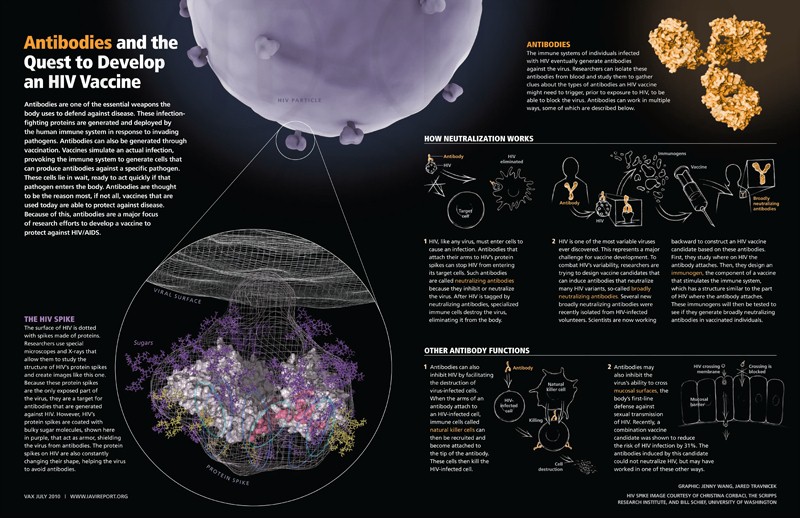Promotional Pamphlet for IAVI
This illustration was created as a promotional pamphlet for IAVI to describe the structure, form, function, and infection pathway of the HIV virus. Illustrations by Jared Travnicek, layout by Jenny Wang
Text in this molecular illustration: Antibodies and the Quest to Develop an HIV Vaccine Antibodies are one of the essential weapons the body uses to defend against disease. These Y-shaped, infection-fighting proteins are generated and deployed by the human immune system in response to invading pathogens, such as viruses and bacteria. Antibodies can also be generated through vaccination. Vaccines simulate an actual infection, which provokes the immune system to generate cells that can produce antibodies against a specific pathogen. These cells lie in waiting, ready to act quickly in the future if that pathogen enters the body. Antibodies are thought to be the reason most, if not all, vaccines that are used today are able to protect against disease. Because of this, antibodies are a major focus of research efforts to develop a vaccine to protect against HIV/AIDS.
The HIV Spike The surface of HIV is dotted with spikes made of proteins. Researchers use microscopes to study the structure of HIV's protein spikes and create images like this one. Because these protein spikes are the only exposed part of the virus, they are a target for antibodies that are generated against HIV. However, HIV’s protein spikes are coated with bulky sugar molecules, shown here in purple, that act as armor, shielding the virus from antibodies. The protein spikes on HIV are also constantly changing their shape, helping the virus to avoid antibodies.
Antibodies The immune systems of people infected with HIV generate antibodies against the virus. Researchers can isolate these antibodies from blood and study them to gather clues about the types of antibodies an HIV vaccine would need to trigger, prior to exposure to HIV, to be able to block the virus. Antibodies can work in multiple ways, some of which are described below.
How Neutralization Works Some antibodies that attach their arms to HIV’s protein spikes are able to stop the virus in its tracks by blocking HIV’s ability to infect its target cells, which any virus must do to survive. Antibodies that inhibit this process are called neutralizing antibodies, because in effect they inhibit or neutralize the virus. When HIV is tagged by neutralizing antibodies, other cells of the immune system come and ingest the virus, eliminating it from the body.
HIV is one of the most variable viruses ever discovered. This represents a major challenge for vaccine development. To combat HIV’s variability, researchers are trying to design vaccine candidates that can induce antibodies that can neutralize many HIV variants, so-called broadly neutralizing antibodies. Several broadly neutralizing antibodies were recently isolated from HIV-infected volunteers.
Scientists are now trying to construct an HIV vaccine candidate based on these antibodies. First, they study where on HIV the antibody attaches. This information is then used to design an immunogen, the component of a vaccine that stimulates the immune system. Then the candidate is tested to see if it generates broadly neutralizing antibodies. This reverse approach is a new way of trying to develop a vaccine.
Other Antibody Functions Antibodies can also inhibit HIV by facilitating the destruction of virus-infected cells. Recently, a combination vaccine candidate was shown to reduce the risk of HIV infection by 31%. Researchers speculate the antibodies induced by this candidate, which could not neutralize HIV, may have worked in this way. Broadly neutralizing antibodies may also work in this manner, in addition to neutralization.
Antibodies that bind to HIV’s protein spikes may also inhibit the virus’s ability to cross mucosal surfaces, such as those in the genitals, which are the body’s first line defense against sexual transmission of the virus.










































